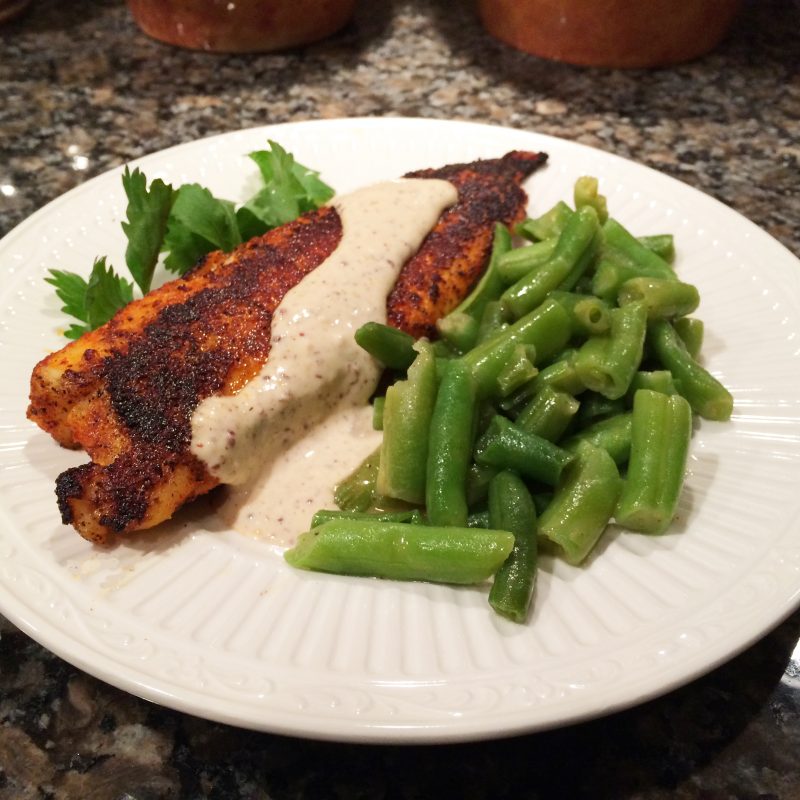When your friends and family ask, "What makes this taste so good?"...
You can proudly say, "It's My Rub!"
When your friends and family ask, "What makes this taste so good?"...
You can proudly say, "It's My Rub!"

Blackened Fish Recipe Summary:
In-Depth Blackened Fish Recipe:
 Blackened fish is one of my favorite things to eat and “It’s My Rub!” Power Blend is great for blackening fish. I have blackened Tilapia, Catfish, Redfish and several other types of fish, but typically I blacken Tilapia.
Blackened fish is one of my favorite things to eat and “It’s My Rub!” Power Blend is great for blackening fish. I have blackened Tilapia, Catfish, Redfish and several other types of fish, but typically I blacken Tilapia.
What am I Looking for in Blackened Fish?
I am looking for a piece of fish that breaks away gently with the edge of my fork when on my plate. I want the fish to be moist and delicate, but not falling apart and over cooked. I do not want a fishy smell or taste. I love to taste a little seasoning that enhances the flavor of the fish, but doesn’t overtake it. I want blackened fish goodness!
Pictured with Underwood’s homemade Remoulade Sauce (recipe to be posted) and
Underwood’s favorite Country Stye Green Beans (recipe to be posted)
Frozen
The technique of blackening that I use came from Chef Paul Prudhomme. This technique cooks the fish very quickly and imparts a wonderful flavor into the food. The concept here is to add the clarified butter or a high smoke point oil to the meat. The oil and moisture from the meat protects it from burning while the fish cooks. So, you are adding the oil to the meat rather than to the pan. This allows you to heat the pan to a very high heat. The meat cooks very quickly.
Trim or Pound for a Uniform Thickness
You want to take your fish fillets and analyze them for even thickness. If you have some areas that are very thick and others that are very thin, you will need to trim the fish to a uniform thickness. You also can make the fish uniform by pounding it thinner. Put a piece of fish between two pieces of plastic wrap and then using the back of a meat mallet or sauce pan, lightly pound the fish thinner. Usually you will not need to apply a lot of force because fish is fairly delicate.
Preparation
 Cover the fish with a high smoke point oil or clarified butter. I prefer grape seed oil, but canola or peanut oil works fine too. If using clarified butter, you need to allow the fish to get to room temperature or it will cause the butter to clump up.
Cover the fish with a high smoke point oil or clarified butter. I prefer grape seed oil, but canola or peanut oil works fine too. If using clarified butter, you need to allow the fish to get to room temperature or it will cause the butter to clump up.
Sprinkle the meat generously with “It’s My Rub!” Power Blend.
Let stand for about 30 minutes before cooking to allow the seasoning to penetrate the meat.
Heat a cast iron or heavy frying pan to very high heat. The pan should, literally, be smoking hot. Do not put oil into the pan.
Put the fish on the searing hot pan.
Be patient and do not try to move the fish too quickly and do not flip it back and forth. The meat will let you know when it is ready to be flipped over by “letting go”. In other words, after about a minute, take your spatula and gently try to lift the meat to turn it over. If the meat separates from the pan easily, it is ready to flip, but if it is still sticking, just wait and try again after 20 or 30 seconds.
In other words, after about a minute, take your spatula and gently try to lift the meat to turn it over. If the meat separates from the pan easily, it is ready to flip, but if it is still sticking, just wait and try again after 20 or 30 seconds.
When is it Done?
 You can determine doneness by pushing on the flesh with your finger. The fish should be more delicate and the grains of the flesh should begin to separate when you push on it. If they begin to fall apart, it is over cooked. However, some pieces of fish may not be uniform in thickness. If this is the case, you want to test the thicker areas to make sure they are done.
You can determine doneness by pushing on the flesh with your finger. The fish should be more delicate and the grains of the flesh should begin to separate when you push on it. If they begin to fall apart, it is over cooked. However, some pieces of fish may not be uniform in thickness. If this is the case, you want to test the thicker areas to make sure they are done.
I hope this helps with your first, or next blackened fish! And, when people ask, “what makes this taste so good?”…you can proudly say, “It’s My Rub!”
Thanks for reading!
Bruce and Kelley Underwood
Copyright 2014 Underwood’s It’s My Food!, LLC
907 Farm Path, Brenham, TX 77833| Email:
bruce.underwood@itsmyrub.com | Phone: 512-635-6052
Copyright 2021, Underwood's "It's My Food!", LLC. All Rights Reserved.